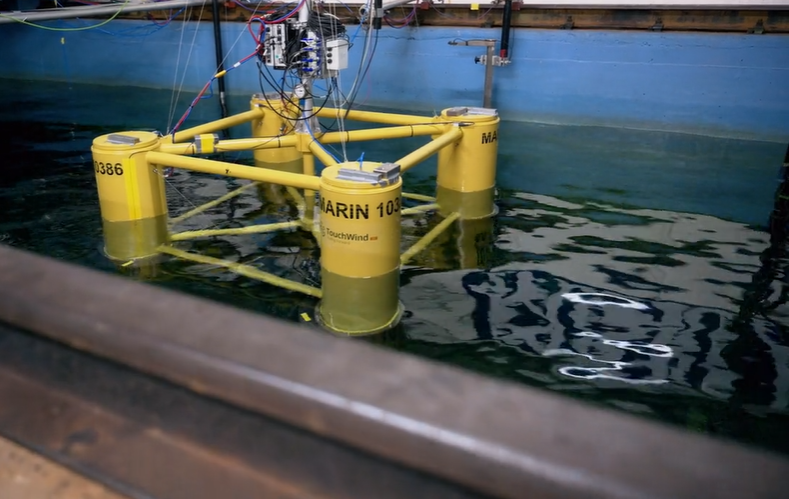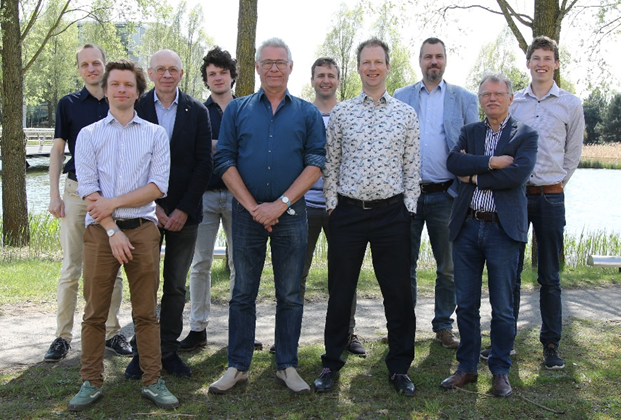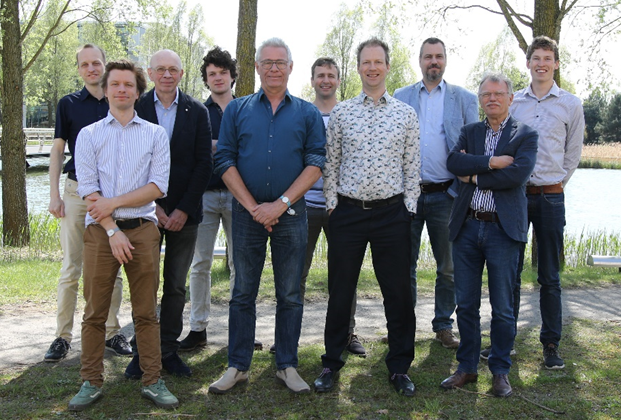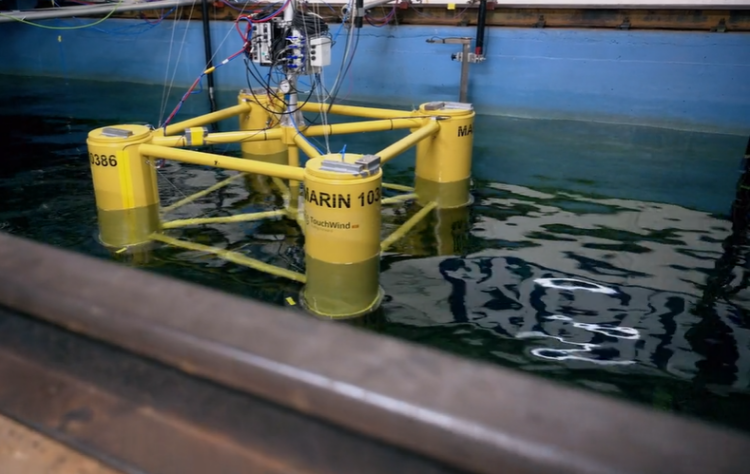




TouchWind-PoP
Create a MARIN account to stay updated

April 2023, no. 135
Report
Supporting clients with their innovations is a core part of MARIN’s strategy and this was recently highlighted when TouchWind's pioneering floating offshore wind turbine was tested in the Concept Basin.

Designed by Dutch startup company TouchWind, the new floater design’s behaviour was successfully tested while being exposed to a storm occurring once in 100 years in harsh North Sea conditions. The floater faced winds of 50m/s and a significant wave height of 13 m. As well as wind and wave loads, mooring systems were examined.
TouchWind Mono
Named TouchWind Mono, the design is unusual compared to conventional turbines because it has a tilting, one-piece rotor, making it robust and reliable. The proof of principle concept study is supported by a subsidy from the Netherlands Enterprise Agency (RVO).
Floor Spaargaren

Project Manager Floor Spaargaren, who focuses on conceptual designs, comments: “We have a great collaboration with TouchWind and have been working with the company since 2020. Originally, TouchWind designed a concept where the whole floater would be tilting, but we did some calculations and jointly decided on a new approach which led to this latest design. It is really nice to be able to support them right from the early stage of the project.”
Models and numerical studies
MARIN has a lot of experience in this arena and has tested dozens of turbine designs over the years. A test setup that modelled the wind loads using small fans on the tower was deployed. This setup was flexible enough to be able to model the vertical components of the wind loads.
“We can evaluate different design variations both at model scale in the basin and also through numerical simulations,” she says.
Currently, two numerical studies are also underway. One is a workability study examining if the mast can be lowered for maintenance purposes and if this results in the turbine having better workability levels than conventional turbines. The second is considering the use of synthetic ropes as mooring lines. Here MARIN is deploying its time domain software aNySIM XMF.
6 m prototype
TouchWind has also developed a 6 m prototype which is being installed in a Dutch lake in March. This will be monitored for two years.
As well as MARIN, TouchWind’s partners for this project include TU Delft, VDL, We4Ce and Nidec.
Thirty years ago, TouchWind was born when founder Rikus van de Klippe graduated with an aerospace engineering degree from Delft University of Technology and went searching for a more meaningful application of his fascination for technology which would support his ambition to make wind energy more affordable.
After extensive R&D and trial and error, he developed the pioneering concept of the TouchWind Mono, which is specifically designed for floating wind farms, and in 2018 he established a small team.
Arne van de Mortel, Senior System Engineer, explains: “The entire rotor assembly tilts into the wind. It can either go into ‘helicopter mode’ – straight upwards - or tilt up to 60 degrees. Normally turbines would have stop producing in rough weather, but the TouchWind Mono can operate in winds up to 70m/s.
“We had weekly meetings with Floor and the team. MARIN really helped us develop the concept even further by thinking along with us.
This was very important because we didn’t have all the knowledge needed in-house. For example, they helped us choose the correct conditions to test the rotor in and which mooring system would be suitable.
“The standard tests demonstrated that the floater was stable and actually much better than expected. Therefore, we decided to push on and test the rotor in more extreme weather events.”
As well as MARIN, TouchWind’s partners for this project include TU Delft, VDL, We4Ce and Nidec.

TouchWind Team (2021).
More info:

Touchwind.org
Free basin time for MKB concept testing



April 2023, no. 135








TouchWind-PoP
Free basin time for MKB concept testing
Touchwind.org

More info:
TouchWind Team (2021).

This was very important because we didn’t have all the knowledge needed in-house. For example, they helped us choose the correct conditions to test the rotor in and which mooring system would be suitable.
“The standard tests demonstrated that the floater was stable and actually much better than expected. Therefore, we decided to push on and test the rotor in more extreme weather events.”
As well as MARIN, TouchWind’s partners for this project include TU Delft, VDL, We4Ce and Nidec.
Thirty years ago, TouchWind was born when founder Rikus van de Klippe graduated with an aerospace engineering degree from Delft University of Technology and went searching for a more meaningful application of his fascination for technology which would support his ambition to make wind energy more affordable.
After extensive R&D and trial and error, he developed the pioneering concept of the TouchWind Mono, which is specifically designed for floating wind farms, and in 2018 he established a small team.
Arne van de Mortel, Senior System Engineer, explains: “The entire rotor assembly tilts into the wind. It can either go into ‘helicopter mode’ – straight upwards - or tilt up to 60 degrees. Normally turbines would have stop producing in rough weather, but the TouchWind Mono can operate in winds up to 70m/s.
“We had weekly meetings with Floor and the team. MARIN really helped us develop the concept even further by thinking along with us.
“We can evaluate different design variations both at model scale in the basin and also through numerical simulations,” she says.
Currently, two numerical studies are also underway. One is a workability study examining if the mast can be lowered for maintenance purposes and if this results in the turbine having better workability levels than conventional turbines. The second is considering the use of synthetic ropes as mooring lines. Here MARIN is deploying its time domain software aNySIM XMF.
6 m prototype
TouchWind has also developed a 6 m prototype which is being installed in a Dutch lake in March. This will be monitored for two years.
As well as MARIN, TouchWind’s partners for this project include TU Delft, VDL, We4Ce and Nidec.
Project Manager Floor Spaargaren, who focuses on conceptual designs, comments: “We have a great collaboration with TouchWind and have been working with the company since 2020. Originally, TouchWind designed a concept where the whole floater would be tilting, but we did some calculations and jointly decided on a new approach which led to this latest design. It is really nice to be able to support them right from the early stage of the project.”
Models and numerical studies
MARIN has a lot of experience in this arena and has tested dozens of turbine designs over the years. A test setup that modelled the wind loads using small fans on the tower was deployed. This setup was flexible enough to be able to model the vertical components of the wind loads.
Floor Spaargaren

Designed by Dutch startup company TouchWind, the new floater design’s behaviour was successfully tested while being exposed to a storm occurring once in 100 years in harsh North Sea conditions. The floater faced winds of 50m/s and a significant wave height of 13 m. As well as wind and wave loads, mooring systems were examined.
TouchWind Mono
Named TouchWind Mono, the design is unusual compared to conventional turbines because it has a tilting, one-piece rotor, making it robust and reliable. The proof of principle concept study is supported by a subsidy from the Netherlands Enterprise Agency (RVO).
Supporting clients with their innovations is a core part of MARIN’s strategy and this was recently highlighted when TouchWind's pioneering floating offshore wind turbine was tested in the Concept Basin.

Report



